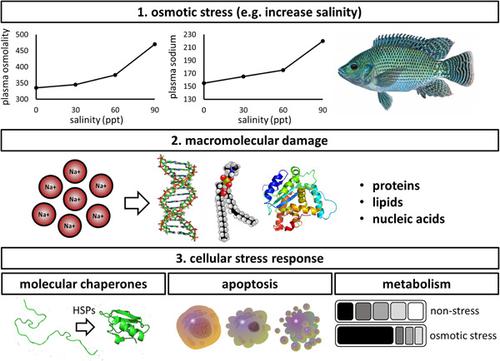当前位置:
X-MOL 学术
›
J. Exp. Zool. Part A
›
论文详情
Our official English website, www.x-mol.net, welcomes your
feedback! (Note: you will need to create a separate account there.)
The cellular stress response in fish exposed to salinity fluctuations.
Journal of Experimental Zoology Part A ( IF 1.9 ) Pub Date : 2020-02-11 , DOI: 10.1002/jez.2350 Tyler G Evans 1 , Dietmar Kültz 2
Journal of Experimental Zoology Part A ( IF 1.9 ) Pub Date : 2020-02-11 , DOI: 10.1002/jez.2350 Tyler G Evans 1 , Dietmar Kültz 2
Affiliation

|
Salinity stress occurs when salt concentration in the environment changes rapidly, for example because of tidal water flow, rainstorms, drought, or evaporation from small bodies of water. However, gradual changes in salt concentration can also cause osmotic stress in aquatic habitats if levels breach thresholds that reduce the fitness of resident organisms. The latter scenario is exemplified by climate change driven salinization of estuaries and by dilution of ocean surface salinity through changes in the water cycle. In this review, we discuss how fish employ the evolutionarily conserved cellular stress response (CSR) to cope with these different forms of salinity stress. Macromolecular damage is identified as the cause of impaired physiological performance during salinity stress and serves as the signal for inducing a CSR. Basic aspects of the CSR have been observed in fish exposed to salinity stress, including repair and protection of cellular macromolecules, reallocation of energy, cell cycle arrest, and in severe cases, programmed cell death. Osmosensing and signal transduction events that regulate these aspects of the CSR provide a link between environmental salinity and adaptive physiological change required for survival. The CSR has evolved to broaden the range of salinities tolerated by certain euryhaline fish species, but is constrained in stenohaline species that are sensitive to changes in environmental salinity. Knowledge of how the CSR diverges between euryhaline and stenohaline fish enables understanding of physiological mechanisms that underlie salt tolerance and facilitates predictions as to the relative vulnerabilities of different fish species to a rapidly changing hydrosphere.
中文翻译:

暴露于盐度波动的鱼类的细胞应激反应。
当环境中的盐浓度快速变化时,例如由于潮汐水流,暴雨,干旱或小水体的蒸发,就会发生盐分胁迫。但是,盐浓度的逐渐变化也可能导致水生生境中的渗透压,如果水平超过了降低常驻生物体适应性的阈值。后一种情况的例子是气候变化驱动的河口盐渍化,以及通过水循环变化而稀释海洋表面盐分。在这篇综述中,我们讨论了鱼类如何利用进化上保守的细胞应激反应(CSR)来应对这些不同形式的盐度应激。大分子损伤被鉴定为盐度胁迫期间生理性能受损的原因,并且是诱导CSR的信号。在暴露于盐胁迫的鱼类中已观察到CSR的基本方面,包括细胞大分子的修复和保护,能量的重新分配,细胞周期停滞以及在严重情况下程序性细胞死亡。渗透反应和信号转导事件调节了CSR的这些方面,为环境盐度与生存所需的适应性生理变化之间提供了联系。CSR的发展已扩大了某些淡碱性鱼类所能容忍的盐度范围,但受限于对环境盐度变化敏感的替人盐沼物种。
更新日期:2020-02-11
中文翻译:

暴露于盐度波动的鱼类的细胞应激反应。
当环境中的盐浓度快速变化时,例如由于潮汐水流,暴雨,干旱或小水体的蒸发,就会发生盐分胁迫。但是,盐浓度的逐渐变化也可能导致水生生境中的渗透压,如果水平超过了降低常驻生物体适应性的阈值。后一种情况的例子是气候变化驱动的河口盐渍化,以及通过水循环变化而稀释海洋表面盐分。在这篇综述中,我们讨论了鱼类如何利用进化上保守的细胞应激反应(CSR)来应对这些不同形式的盐度应激。大分子损伤被鉴定为盐度胁迫期间生理性能受损的原因,并且是诱导CSR的信号。在暴露于盐胁迫的鱼类中已观察到CSR的基本方面,包括细胞大分子的修复和保护,能量的重新分配,细胞周期停滞以及在严重情况下程序性细胞死亡。渗透反应和信号转导事件调节了CSR的这些方面,为环境盐度与生存所需的适应性生理变化之间提供了联系。CSR的发展已扩大了某些淡碱性鱼类所能容忍的盐度范围,但受限于对环境盐度变化敏感的替人盐沼物种。











































 京公网安备 11010802027423号
京公网安备 11010802027423号